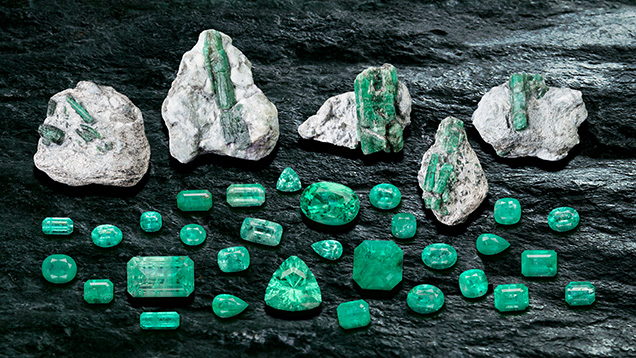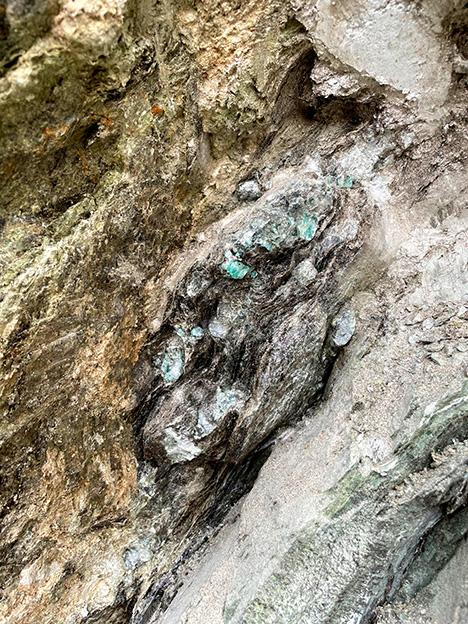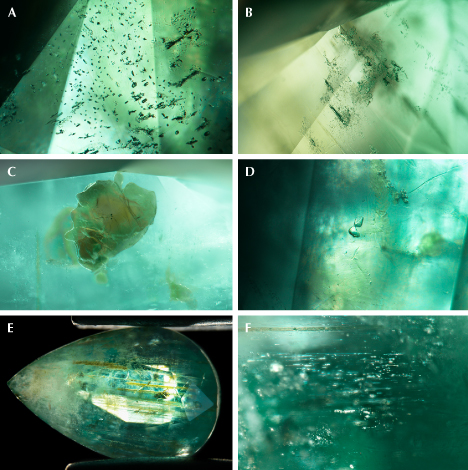New Emerald Production from the Curlew Mine, Western Australia

Australian emeralds have been known for over a century but have always maintained a low profile. Small volumes, low clarity, and desaturated color were among the reasons for their lack of recognition in the global market.
One of Australia’s emerald deposits is the Curlew mine in the Shire of East Pilbara in Western Australia. This area has been worked officially since the mid-1970s, but anecdotal evidence suggests that emeralds were known at least 50 years prior to that. During this initial period of mining, the focus was on specimen collecting. Any gem-quality material was sold to Indian-based emerald manufacturers and disappeared into the vast pool of emeralds with undetermined origin.
From the 1980s to 2011, the mine was largely abandoned, although a few (unsuccessful) attempts were made to revitalize the deposit. In 2011, a prospecting license was passed between different groups with little success in emerald production. In recent years, the mining license was taken over by a small-scale mining group. They successfully produced gem-quality material from the existing pit during the 2023 mining season. Production was limited to a few kilograms of gem-quality material, but the owners intend to scale up the production in 2024.
GIA’s Bangkok laboratory was able to study a suite of 69 emeralds from this recent production (figure 1) that was on loan from the miner. The rough emerald crystals showed a well-formed hexagonal outline, often coated with dark mica crystals. Other minerals associated with the emerald were identified as feldspar and quartz. One of the matrix specimens also contained significant volumes of purple fluorite (confirmed by Raman spectroscopy).

The combination of these matrix minerals, especially mica, suggests that these stones formed in the contact zone of a pegmatite intrusion into an (ultra-)mafic rock. Images from the emerald mineralization in the field confirmed this (figure 2). This type of geological environment, found at many other emerald deposits around the world, is responsible for the majority of emeralds in the marketplace, including Kafubu (Zambia), the Ural Mountains (Russia), Shakiso (Ethiopia), and Itabira (Brazil).
The refractive index of the stones was 1.580–1.586 ± 0.001, with a birefringence of 0.007. This is in the higher range for emerald and corresponds with other emeralds that form in a similar geological environment.

Chemical analysis using laser ablation–inductively coupled plasma–mass spectrometry (LA-ICP-MS; see table 1) and spectroscopic analysis confirmed that these emeralds were rich in iron. Ultraviolet/visible/near-infrared spectroscopy revealed chromium-related absorption features as well as a strong band around 810 nm, which is attributed to the higher iron concentration. This band is used to separate high-iron, schist-hosted emeralds from hydrothermal, low-iron emeralds (e.g., Colombia and Afghanistan).

Various inclusions were seen in the emeralds (figure 3). Very fine fluid inclusions had a blocky outline, sometimes elongated as tubes, with a single bubble inside. In many cases, they were surrounded by a frosty rim that was large enough to obscure the fluid inclusion. No color zoning was observed, but some of the cleaner stones showed wavy to straight graining.
Two types of crystal inclusions were observed, the most common being dark mica platelets and the other consisting of small transparent colorless crystals. With the use of confocal Raman spectroscopy, some of these transparent crystals were identified as feldspar and others as fluorite. Several stones also showed clusters of short needles mixed with smaller reflective particles, sometimes forming fields of “dusty” particles. A handful of stones had large, wide tubes stained with orangy brown iron mineralization.
Overall, this inclusion scene shares many similarities with samples from other high-iron emerald sources such as Kafubu and Itabira (S. Saeseaw et al., “Geographic origin determination of emerald,” Winter 2019 G&G, pp. 614–646).
The trace element composition of Curlew emeralds (table 1) allows for separation from other high-iron emerald sources, although multiple elements should be taken into account to clearly separate the Australian emeralds from those found in Russia and Nigeria.
Emeralds from this renewed activity at the Curlew mine in Australia only started to enter the global emerald trade in late 2023. Their appearance and characteristics are in line with other high-iron, schist-hosted emeralds such as those from Zambia, Brazil, and Russia. Inclusions offer limited clues for origin determination, which relies heavily on trace element analysis and correct interpretation of these results.
.jpg)


